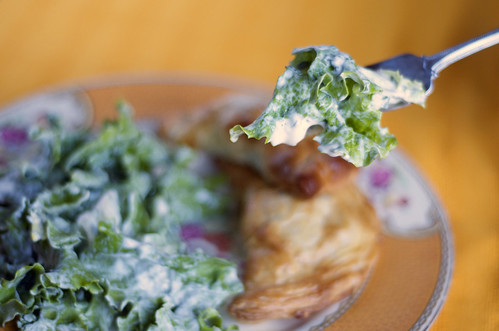Green Goddess dressing
I've had something of a fascination lately with the idea of San Francisco food. I mean, everyone knows our fair city to be a major foodie destination, and most people can rattle off a list of restaurant names of varying degrees of prestige in the current-day food scene. But what of the classics, the dishes that emerged from restaurants past and present that have made it into the American culinary vernacular?
Many of these dishes have appeared on menus for so long, they've been fallen out of fashion and are now associated with lunching matrons in chi-chi hotel restaurants: Crab Louie, Celery Victor and the grandmother of all creamy salad dressings, Green Goddess.
It's small wonder these dishes have become culinary dinosaurs. In the monotony of preparing them on so many menus over so many years, they've surely slid into mediocrity or worse at the hands of indifferent chefs. Just recently, I dined locally at an otherwise perfectly good establishment (that shall remain nameless). I was actually excited to see a salad with Green Goddess on the menu, and ordered it with glee. Sadly, I was presented a lackluster pile of greens thickly coated with what as far as I could tell was just straight-up mayonnaise. No green, and far from godly.
But I maintain that when prepared with love and integrity, these foods must be excellent in their own right. How else could they have become such culinary icons?
And the goddess is an icon indeed. It was created at the Palace Hotel in 1923 by Executive Chef Phillip Roemer at an event to honor actor George Arliss, who was then the lead in the play "The Green Goddess" by William Archer. Cool, creamy and fresh with herbs, it must have struck quite a chord with the diners that evening, for it went on to become one of the most popular dressings in the West for decades, eventually dethroned by ranch dressing (with which it has a more than passing resemblance.)
Its fame peaked in the 1970s when Seven Seas sold a bottled version of it, and today Annie's Naturals produces a version as well, but for the last three decades or so, the goddess has largely lost her followers.
Well, consider me a member of the Cult of the Green Goddess, then. And I aim to convert you, too.
You see, Green Goddess is much more than a dressing. Since I've started making it, it's made its way into a variety of applications. It makes a fantastic dip for just about anything on its own, but toss it into a blender with some white beans and you've got something rather special indeed. Our friend Jim's mother used to use it as a dressing for cold pasta, and served with grilled jumbo shrimp; I think scallops would be at least as delightful.
In researching the dressing, I came across a lot of different recipes with a surprising amount of variation: Different proportions of mayonnaise, sour cream and vinegar; with or without anchovy; and while nearly all call for parsley and chives, others called for basil, tarragon and even chervil. Despite Martha's greatest efforts to market it, however, chervil remains an elusive ingredient for most of us.
The Palace Hotel thoughtfully has published the original, and that is what I used. Well, sort of. While they call for parsley and chives, the original evidently did not include tarragon; this will not stand. For reasons I cannot justify, in my mind Green Goddess must have tarragon. Must. So I added it. And I stand by that decision. Fact is, you could tweak this recipe ten times till Tuesday, and you'd still end up with a delicious, refreshing dressing, so have at it.
What other San Francisco classics do you love? And what current dishes do you think will stand the test of time?
Green Goddess dressing
Adapted from the Palace Hotel, Executive Chef Phillip Roemer, 1923
1 c. mayonnaise
1/2 c. sour cream
1/4 c. each chives, parsley and tarragon, finely chopped
1 Tbsp lemon juice
1 Tbsp white wine vinegar
3 anchovy filets, minced
Salt and pepper to taste
Combine all ingredients in a large bowl and mix well. Cover and refrigerate. Best if made several hours or up to a day ahead. The anchovies can be omitted for a vegetarian version.
Related:
Ellie at Vintage Victuals has a more baroque version.
Serious Eats excerpts a recipe from Endangered Recipes by Lari Robling, which is slightly different than the Palace's official recipe.
Cathy at Noble Pig has a Green Goddess spinach dip that will surely appear at one of our future parties.


 Green Goddess Dressing
Green Goddess Dressing